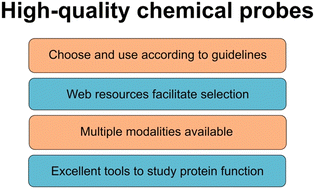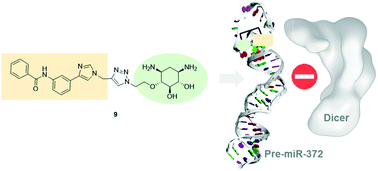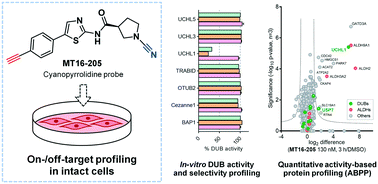Themed collection Chemical Probes

The future of chemical probes is diversity
Guest editors Susanne Müller, Stephen Frye and Jonathan Baell introduce the RSC Medicinal Chemistry themed collection on chemical probes.

RSC Med. Chem., 2022,13, 1438-1438
https://doi.org/10.1039/D2MD90036J
The era of high-quality chemical probes
A brief history of milestones leading to selection and use guidelines for high-quality chemical probes. We highlight their importance to study protein function and illustrate examples of recently developed probes acting through different modalities.

RSC Med. Chem., 2022,13, 1446-1459
https://doi.org/10.1039/D2MD00291D
Polarity-based fluorescence probes: properties and applications
Polarity-sensitive fluorophores can change their fluorescence properties in response to the polarity of local surroundings, such as excitation and emission wavelength (λex, and λem), fluorescence quantum yield (Φf), fluorescence lifetime and so on.

RSC Med. Chem., 2021,12, 1826-1838
https://doi.org/10.1039/D1MD00170A
Recent advances in the development of covalent inhibitors
This is the short review focusing on recent advances of covalent warheads that can be applied to the development of potential covalent inhibitors.

RSC Med. Chem., 2021,12, 1037-1045
https://doi.org/10.1039/D1MD00068C
Development of 2-deoxystreptamine–nucleobase conjugates for the inhibition of oncogenic miRNA production
2-deoxystreptamine (2-DOS) conjugates with artificial nucleobases were designed and synthesized to inhibit pre-miR-372 processing into oncogenic miRNA and were discovered to be promising inhibitors when compared to their neomycin counterpart.

RSC Med. Chem., 2022,13, 311-319
https://doi.org/10.1039/D1MD00345C
Rational design of selective inhibitors of PARP4
PARPs (PARP1-16 in humans) are a large family of ADP-ribosyltransferases (ARTs) that have diverse roles in cellular physiology and pathophysiology.

RSC Med. Chem., 2021,12, 1950-1957
https://doi.org/10.1039/D1MD00195G
Activity-based protein profiling reveals deubiquitinase and aldehyde dehydrogenase targets of a cyanopyrrolidine probe
We report the characterization of a UCHL1 covalent inhibitor based on a thiazole cyanopyrrolidine scaffold and a closely-related activity-based probe (ABP) which was used to generate a quantitative profile for on- and off-targets in human cells.

RSC Med. Chem., 2021,12, 1935-1943
https://doi.org/10.1039/D1MD00218J
Identification of molecular glues of the SLP76/14-3-3 protein–protein interaction
The stabilisation of protein–protein interactions (PPIs) through molecular glues is a novel and promising approach in drug discovery.

RSC Med. Chem., 2021,12, 1555-1564
https://doi.org/10.1039/D1MD00172H
Will the chemical probes please stand up?
This study provides a comprehensive and comparative overview of probe sources, structures and targets. The analysis encompasses 4466 chemical probe candidates supported by evidence of specific binding to 796 human proteins.

RSC Med. Chem., 2021,12, 1428-1441
https://doi.org/10.1039/D1MD00138H
Selective degradation-inducing probes for studying cereblon (CRBN) biology
Thorough compound characterization by combination western and proteomic analysis identified ZXH-4-130 and ZXH-4-137 as potent and selective small molecule degraders of cereblon (CRBN).

RSC Med. Chem., 2021,12, 1381-1390
https://doi.org/10.1039/D0MD00382D
Discovery, synthesis and biological characterization of a series of N-(1-(1,1-dioxidotetrahydrothiophen-3-yl)-3-methyl-1H-pyrazol-5-yl)acetamide ethers as novel GIRK1/2 potassium channel activators
We report the synthesis, biological characterization, and in vitro PK properties of a new ether series of compounds that incorporate the sulfone group while maintaining potency and stability. 11a was identified as a new GIRK1/2 activator with suitable properties.

RSC Med. Chem., 2021,12, 1366-1373
https://doi.org/10.1039/D1MD00129A
About this collection
This themed collection, guest edited by Dr Susanne Müller-Knapp (Goethe University), Professor Stephen Frye (University of North Carolina at Chapel Hill) and Professor Jonathan Baell (Monash University), highlights the latest medicinal chemistry advances in the creation and use of chemical probes as selective tools for enabling target validation and exploration of new biology.
New articles will be added to the collection upon publication. Please return to this page frequently to see the collection grow.